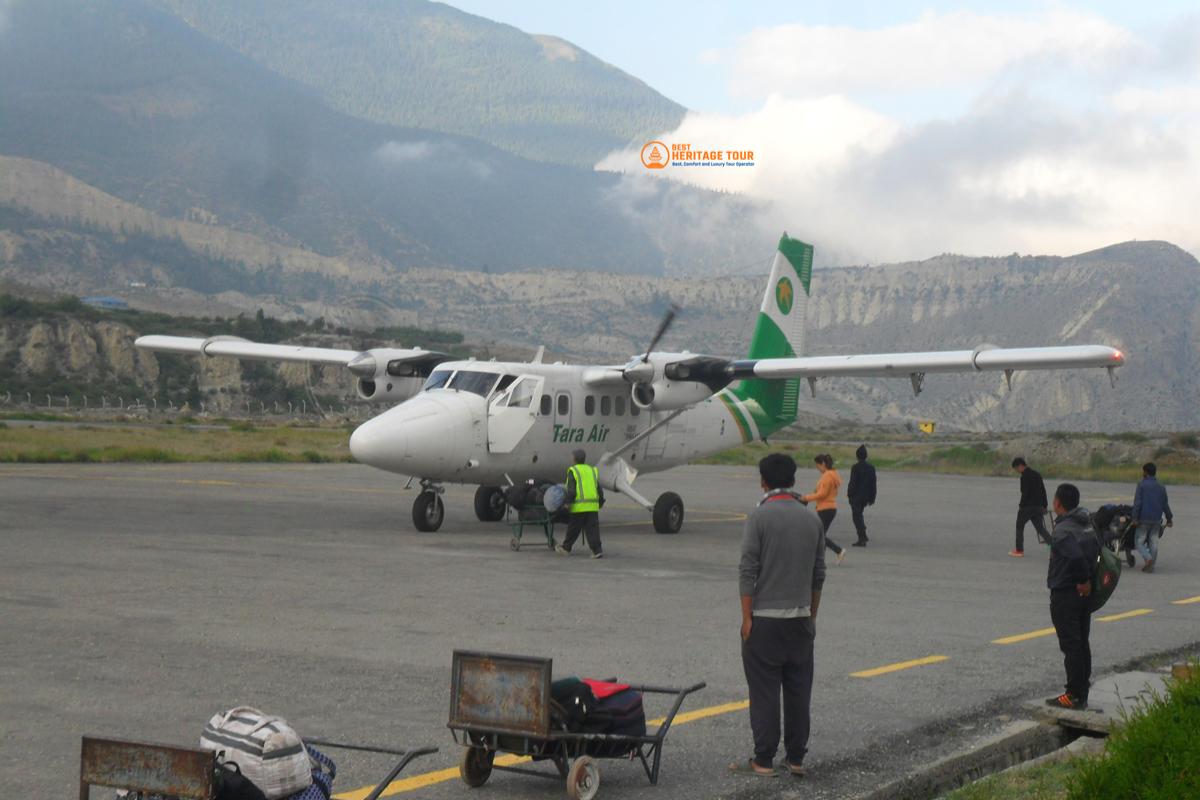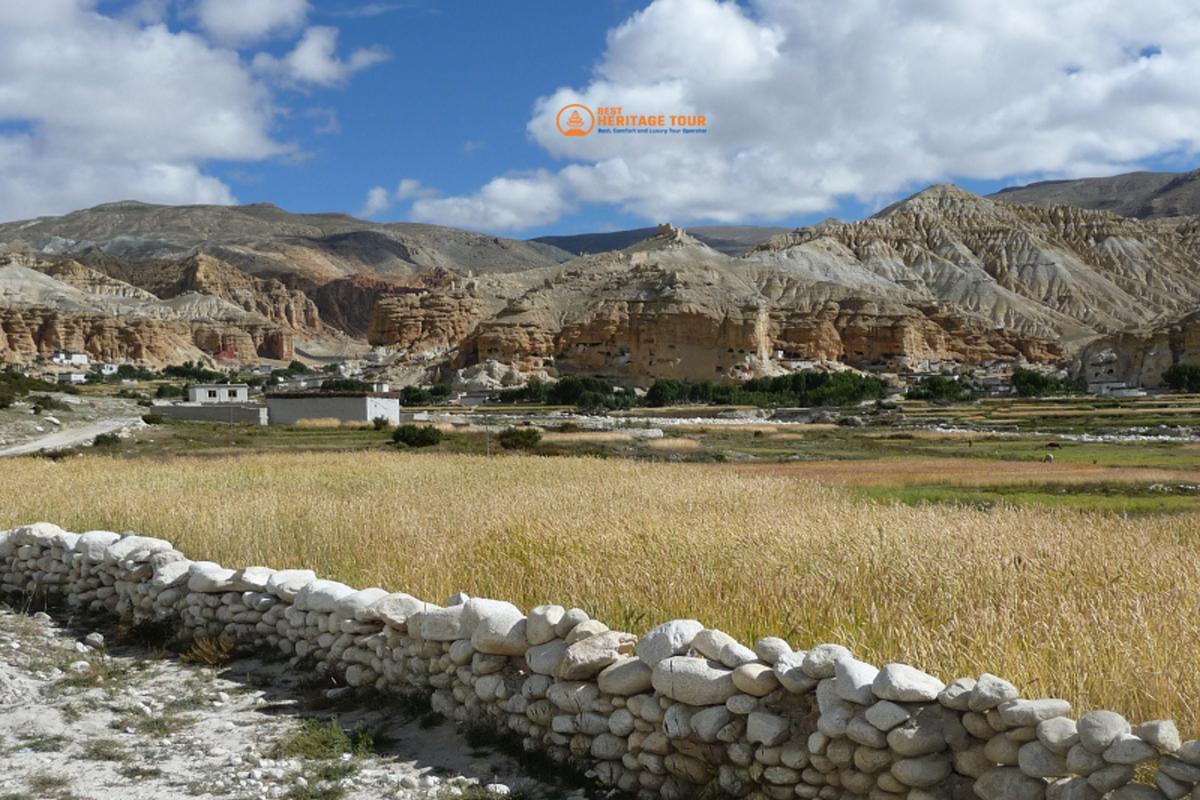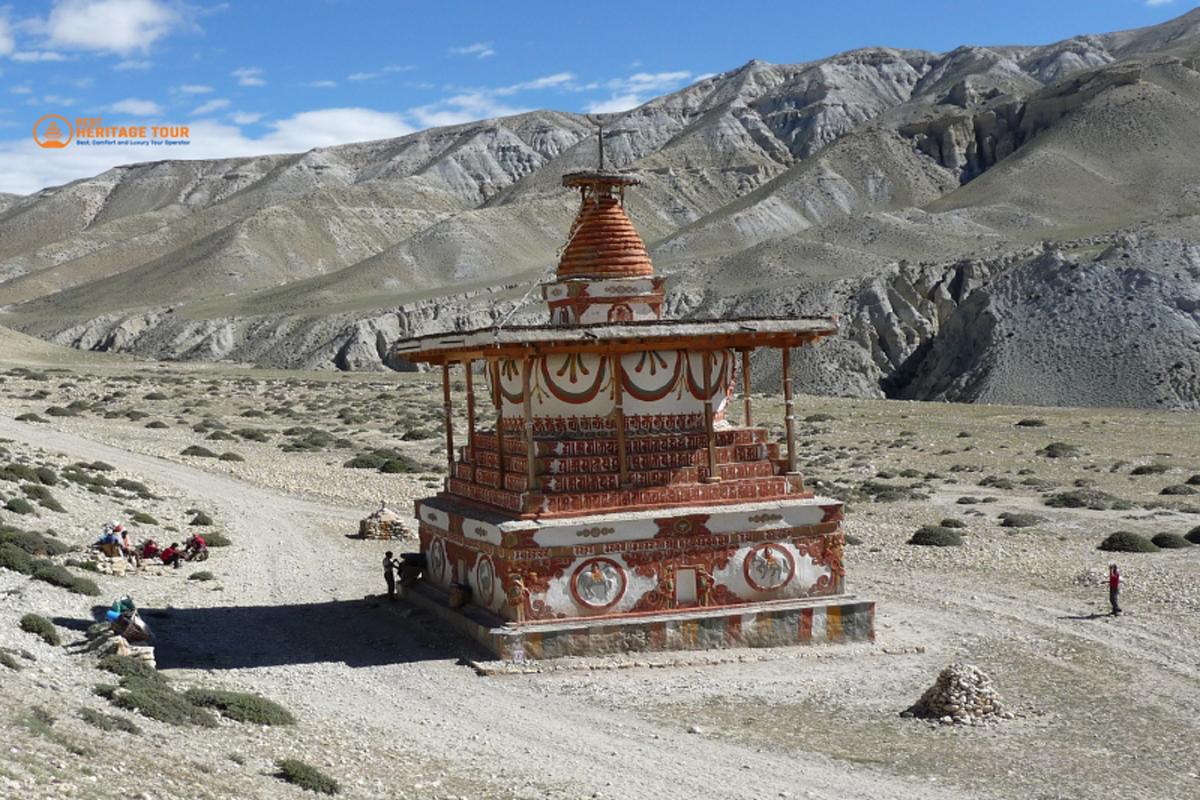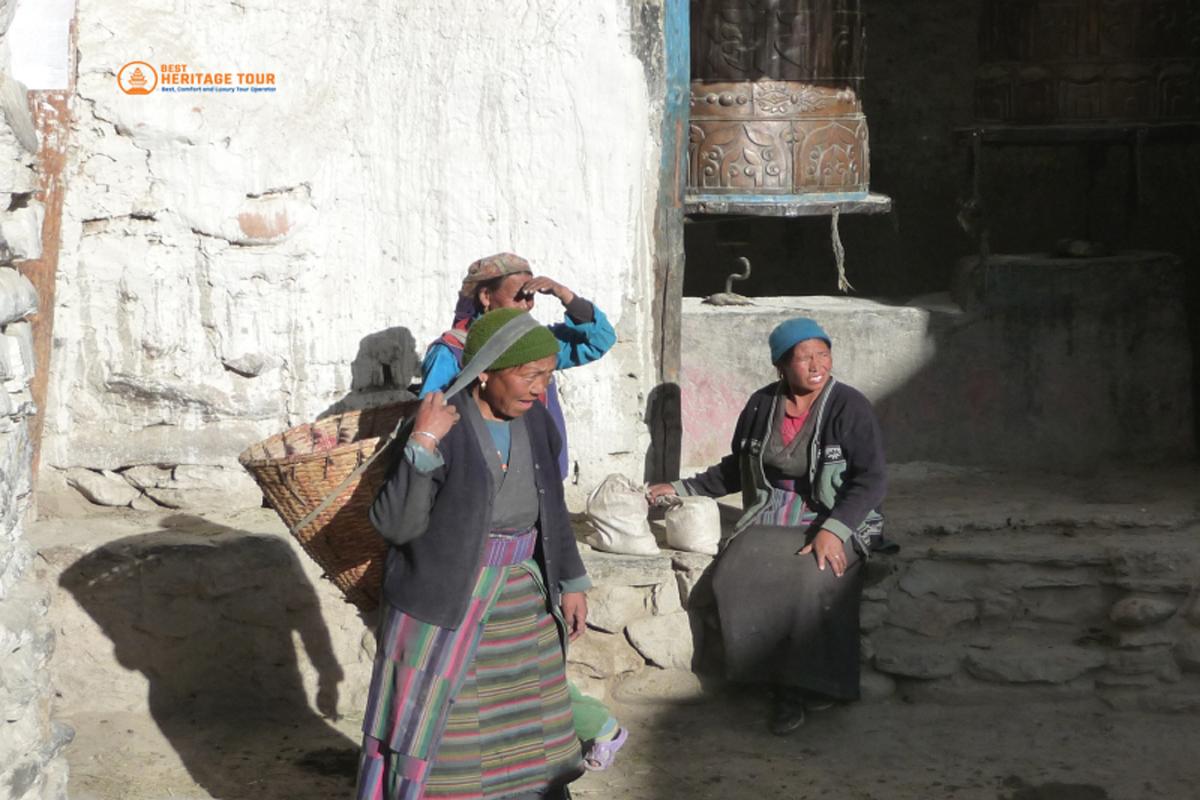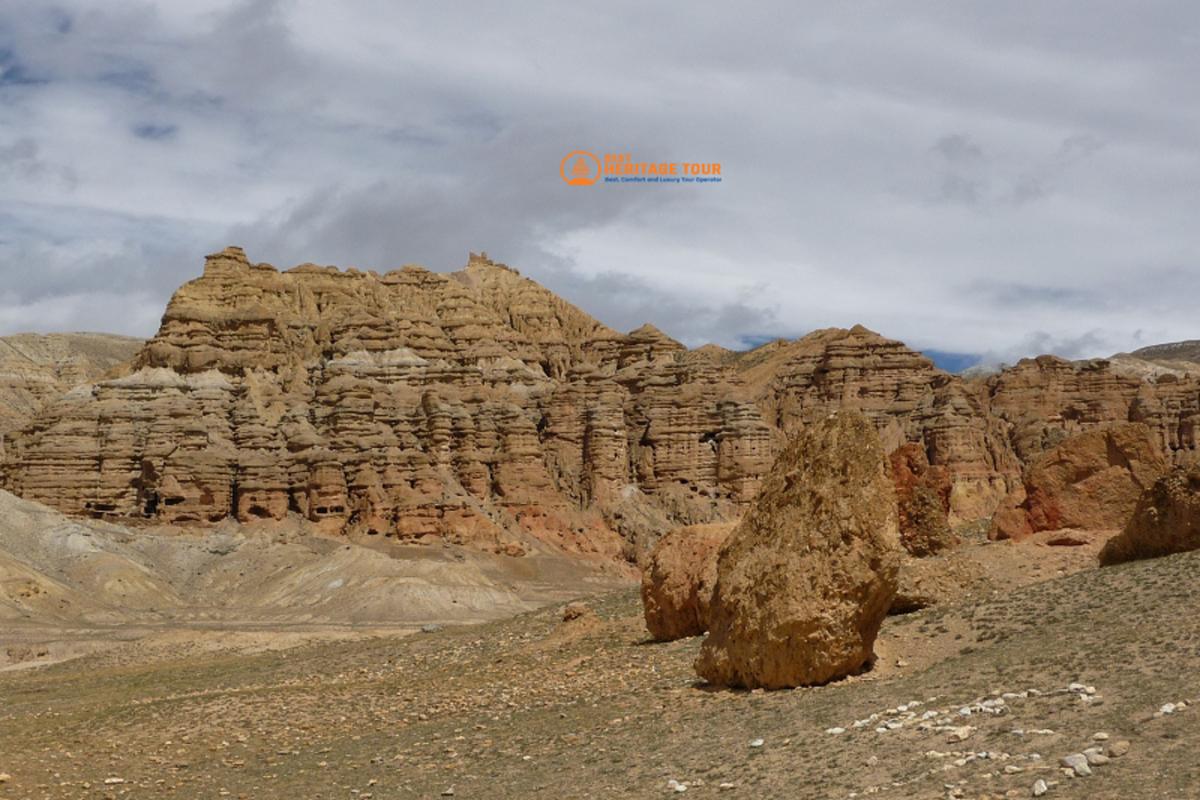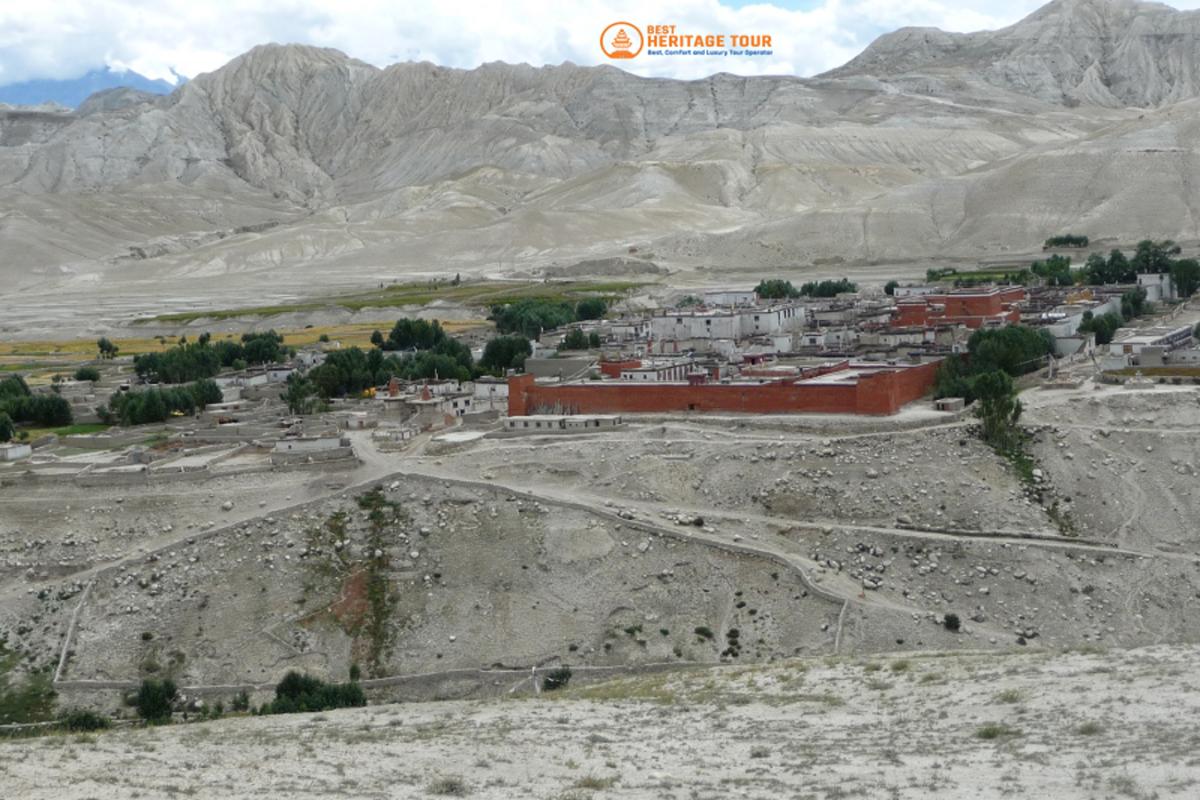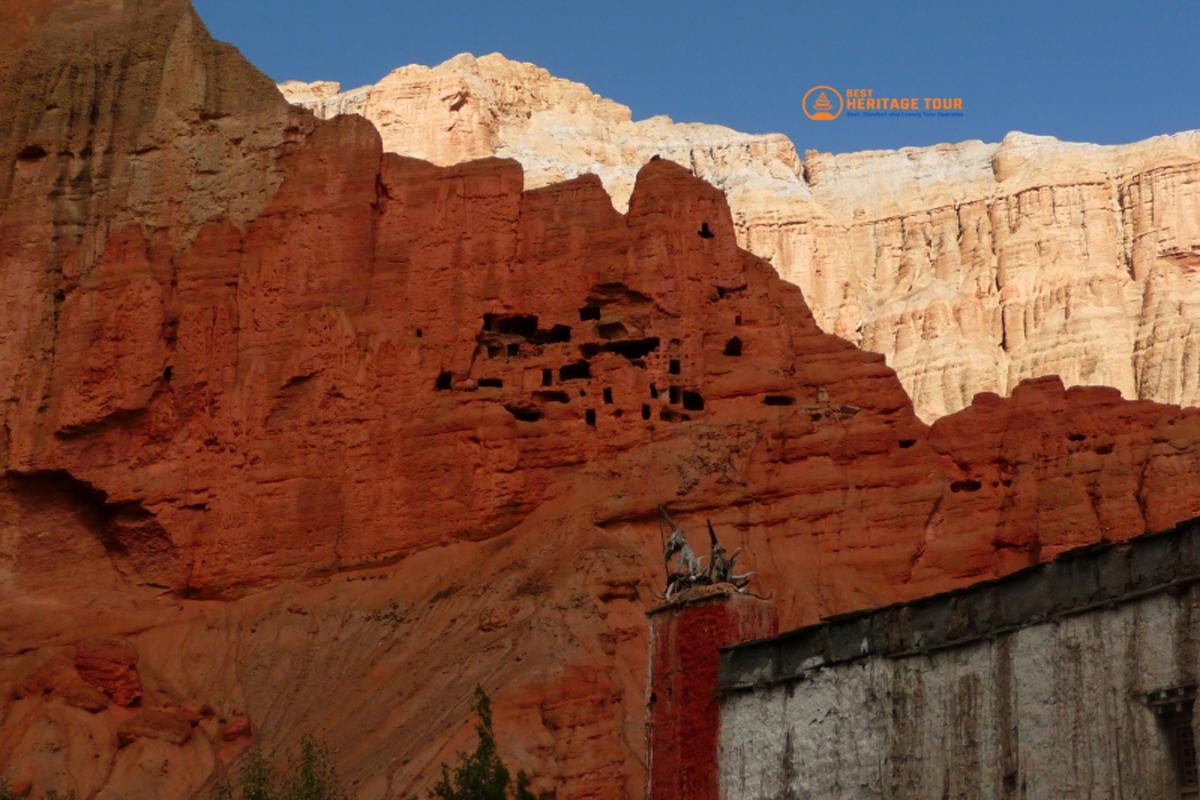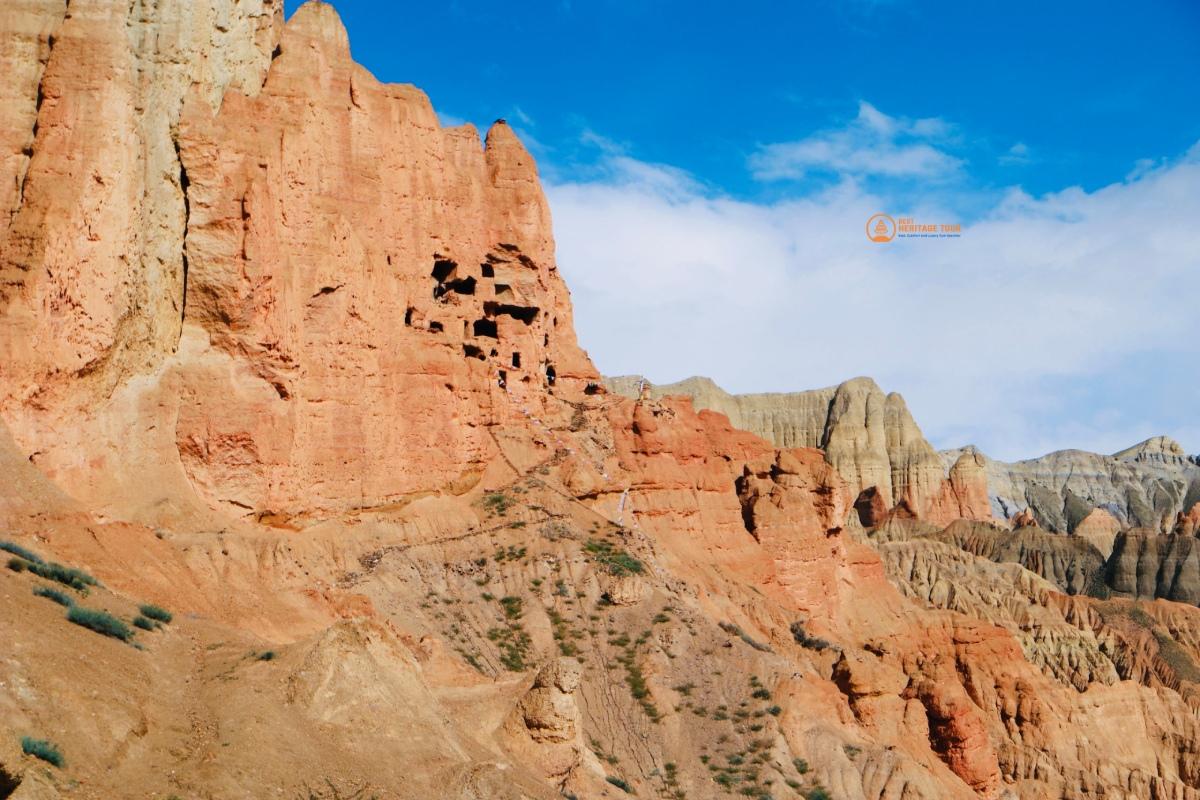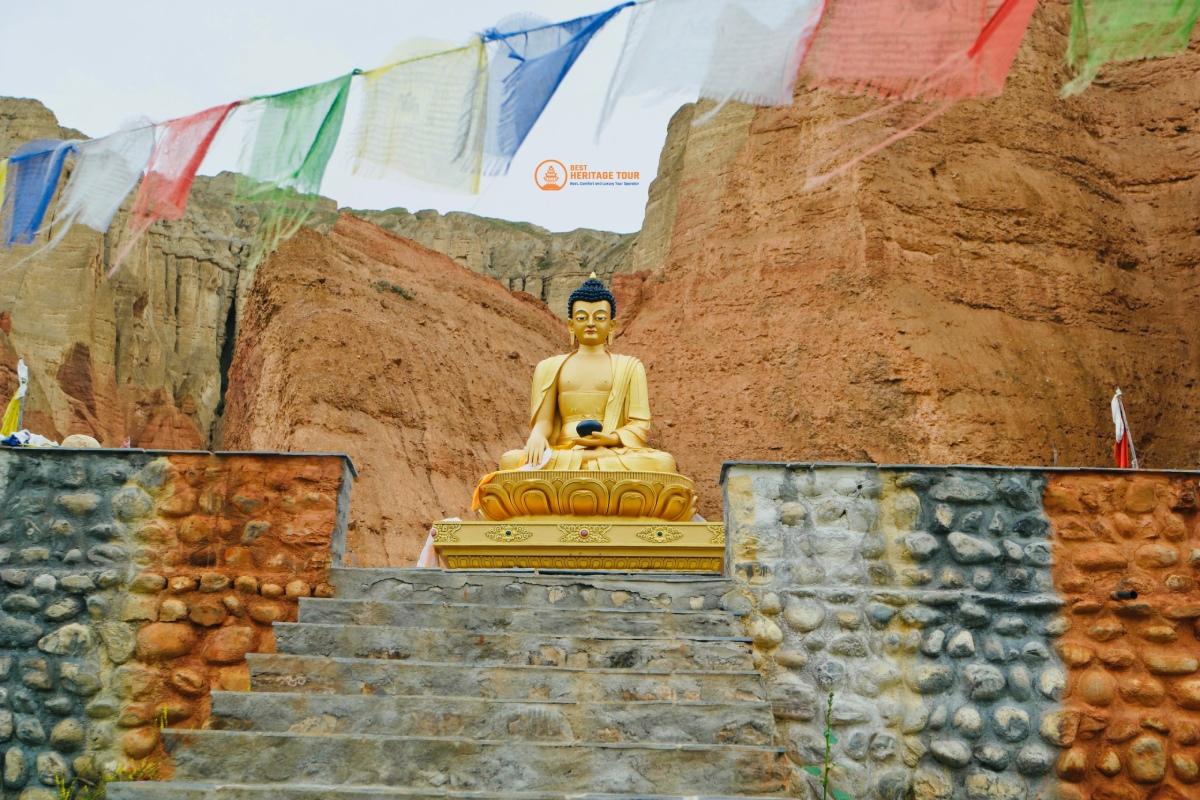Upper Mustang Jeep Tour - 11 Days
Insight on Upper Mustang Jeep Tour
The Upper Mustang Jeep Tour offers an immersive journey through the Upper Mustang region, leading up to Lo Mangthang and highlighting numerous cultural and historical landmarks along the route. This one-of-a-kind adventure allows you to discover the awe-inspiring landscapes of Upper Mustang, all while enjoying the comfort and convenience of a Jeep. Whether you're a seasoned adventurer or seeking an unforgettable journey, this tour promises a remarkable experience.
Trip at a Glance
Key Highlights
- Start with a scenic bus ride from Kathmandu to Pokhara and return at the end of the tour
- Enjoy round-trip flights between Pokhara and Jomsom
- Spend two nights in Pokhara, Nepal’s popular tourist hub
- Visit Jomsom, the main town and administrative center of Mustang
- Explore the Mustang region, including Lo Manthang, the historic capital of the ancient Kingdom of Lo
- Take in breathtaking views of snow-capped peaks like Annapurna, Machhapuchare, Tilicho, Nilgiri, and Bhrikuti
- Experience Tibetan-influenced culture, traditions, and lifestyle
- Visit ancient monasteries, including Luri Gompa, Jampa Monastery, and Thupchen Gompa
- Travel comfortably by Jeep through Mustang’s remote and scenic landscapes
Advantages of the Upper Mustang Jeep Tour with Best Heritage Tour
- Complimentary airport-to-hotel transfers upon arrival and hotel-to-airport transfers upon departure
- Easy booking and reservation process
- Convenient and flexible payment methods
- Multiple communication platforms available (Email, WhatsApp, Facebook, WeChat, Viber, Skype, Zoom)
- 24/7 phone support at: +977-9851149197 / +977-9810043046
- Medical supplies & Oximeters provided to monitor oxygen saturation at high altitudes
- Sleeping bags and trekking poles will be available upon request if required
- Free luggage storage at Best Heritage Tour for the duration of your trip
Trip Overview
The Upper Mustang Jeep Tour gives you a chance to experience the stunning landscapes of the Upper Mustang while exploring its rich culture and history. This tour is perfect for travelers with limited time who still want to see the beautiful dry valleys of the Himalayas, where Tibetan culture is alive and well. The Upper Mustang region, located on the northwest border of Nepal and Tibet, features ancient caves, historic monasteries, and important archaeological sites, making it a top destination for tourists.
Your journey begins with a seven-hour drive from Kathmandu to Pokhara on a tourist bus. After spending a night in Pokhara, you will take a quick twenty-minute flight to Jomsom, offering breathtaking views of the Nepali countryside. Once you land in Jomsom, you will hop into a jeep to travel to Chhusang for your first overnight stay.
The jeep ride continues from Chhusang to Tsarang, passing by Ghar Gompa, an ancient monastery that attracts many visitors. The route takes you through impressive high cliffs, wide barren valleys, and canyon hills. After your visit to Tsarang, you will head to Lo Mangthang, the capital of the Kingdom of Lo since 1380. You will spend a day exploring the various attractions in Lo Mangthang.
After your time in Lo Mangthang, the jeep will take you to Luri Gompa through Chosar Valley. At Luri Gompa, you will find fascinating caves and beautiful Buddhist frescoes. The expedition subsequently returns southward to Jomsom, the initial point of the tour.
The following day, you will fly back to Pokhara, where you can enjoy a full day in this lively tourist hotspot. After one final night in Pokhara, you will take a tourist bus back to Kathmandu, finishing your wonderful Upper Mustang Jeep Tour.
What to Expect on Upper Mustang Jeep Tour
1. Scenic Drive and Flights
Begin your adventure with a scenic bus ride from Kathmandu to Pokhara, passing terraced fields, rivers, and traditional villages along the way. The journey itself offers glimpses of the Himalayan foothills and rural Nepalese life. From Pokhara, take a short flight to Jomsom, which provides stunning aerial views of Annapurna, Dhaulagiri, and other majestic snow-capped peaks. The return flight allows for another chance to appreciate the breathtaking Himalayan panorama.
2. Mustang’s Remote Landscapes
Travel by Jeep through Mustang’s remote and strikingly unique landscapes. Experience desert-like valleys, deep gorges, rocky cliffs, and barren terrain shaped by the Himalayas’ rain shadow. The isolation of this region has preserved its natural beauty and ancient way of life, giving you the rare chance to explore areas rarely visited by most tourists.
3. Ancient Kingdom of Lo
Explore Lo Manthang, the historic walled capital of the ancient Kingdom of Lo. Walk through narrow streets lined with traditional Tibetan-style houses, visit royal palaces, and explore centuries-old monasteries. Each step gives insight into the region’s fascinating history, architecture, and the ways in which traditions have survived for hundreds of years.
4. Tibetan Culture and Traditions
Immerse yourself in Mustang’s unique Tibetan-influenced culture. Interact with local people, observe their daily routines, and witness traditional festivals and ceremonies if your visit coincides. Explore iconic Gompas such as Luri Gompa, Jampa Monastery, and Thupchen Gompa, where you can see religious rituals, prayer wheels, and ancient artwork, providing a deep understanding of the spiritual heritage of the region.
5. Stunning Himalayan Views
Upper Mustang offers unrivaled views of towering Himalayan peaks, including Annapurna, Machhapuchare, Tilicho, Nilgiri, and Bhrikuti. The landscape changes dramatically as you traverse the region, from barren deserts to high passes, providing countless photo opportunities and moments to pause and admire the breathtaking scenery that defines this hidden kingdom.
6. Comfortable Jeep Travel
Travel efficiently and comfortably by Jeep, which allows you to cover long distances while taking in the diverse terrain. The vehicle makes remote villages, high valleys, and scenic viewpoints easily accessible, ensuring you experience the full range of Mustang’s landscapes without the physical strain of long treks.
7. Cultural and Natural Immersion
This journey combines cultural exploration with natural wonders. From historic walled towns and ancient monasteries to desert landscapes and Himalayan panoramas, you gain a well-rounded understanding of Mustang. Witness the harmony between the region’s rugged natural environment and the enduring traditions of its people, leaving you with a deep appreciation for this extraordinary Himalayan kingdom.
Itinerary
Arrive in Kathmandu no later than 3 pm the day before your trip departure date. Upon arrival at Tribhuvan International Airport in Kathmandu, our representative will be holding a Best Heritage Tours brochure with your name on it. Our representative will welcome you to Nepal, present you with a wreath, and transfer you to your hotel in a private vehicle.
Catch a bus to Pokhara and head west along the Prithvi Highway. The journey will take approximately 7 hours and upon arrival, you will enjoy the spectacular views of this picturesque town. Pokhara is called the tourist capital of Nepal. Surrounded by towering snowy mountains and surrounded by several lakes, the city is truly a sight to behold. On a clear day, the majestic snowy peaks reflect off these lakes in Pokhara, adding to the already stunning scenery.
Take an early morning flight to Jomsom, where you'll enjoy spectacular mountain views, including the two eight-thousand peaks of Dhaulagiri and Annapurna. The views are truly impressive from the air, making it an unforgettable experience. The plane lands in Jomsom, the capital of Mustang. The plane lands in Jomsom, the capital of Mustang. The entire flight takes about 20 minutes. After arriving in Jomsom, board a jeep to Chhusang. On the way, you will pass through the Thangbe and Kali Gandaki River valleys.
After breakfast, start the scenic drive to Tsarang. The journey will take you through high cliffs and wide, barren valleys to a small settlement. This route is said to have been taken by the great Indian saint Padmasambhava, known for establishing Tibetan Buddhism in the region between 750 to 810 AD. From the jeep, you will see some truly dramatic and unusual rocks, valleys, hills, and the Kali Gandaki riverbed.
You will make several stops to enjoy the spectacular views, including the towering red cliffs west of Ghami. After crossing the Ghami pass you will reach Tsarang. During the day you will visit the impressive White Palace and Ghar Gompa, both popular with visitors. Both are ancient monasteries.
As you drive from Tsarang towards Lo Mangthang, the capital of Upper Mustang, you will have the chance to see majestic mountains like Tilicho, Mt. Annapurna, Nilgiri, and Bhrikurti. After crossing Lho Pass you will finally reach the beautiful Lo Mangthang valley. You will stop at Lo Mangthang for the night.
Lo Mangthang has around 150 houses and numerous lama residences. The city has four main temples, one of which is Champa Lhakang, featuring a giant clay Buddha and intricately painted mandalas on the walls. At the heart of the city is the magnificent palace where the king and queen once lived. The king and queen were stripped of their titles in 2008 when Nepal became a republic.
Leaving Lo Mangthang, you follow the wide gully road to Chosar town, known for its dark red Gharphu Gompa, where young men are trained to become monks. After about a 2-hour drive, you will reach Luri Gompa, which contains several complex caves filled with Buddhist frescoes and richly painted chortens. You will be overnight stay at Luri Gompa.
Time to head back to Jomsom. First, head south towards Ghami. Follow the same route to Lo Mangthang, but with a change of perspective. The closer you get to Kali Gandaki, the stronger the local winds will be in the afternoon. If all goes well, you can expect to reach Jomsom by late afternoon.
Finally, it's time to head back to Pokhara. After an early breakfast, you'll board a 30-minute flight to Pokhara. Pokhara is a very lively place, and you can spend the rest of your time boating, kayaking, or relaxing in a yoga studio or quirky shop. For those seeking adventure, paragliding is an option to consider.
After an overnight stay in Pokhara, board a tourist bus to Kathmandu. The route is 200 km long and initially follows the course of the Marsyangdi River before merging with the Trishuli River. Alternatively, you can take a flight from Pokhara to Kathmandu at your own expense as it is not included in the tour package. The tour ends in Kathmandu.
You will be transferred to Tribhuvan International Airport for your return flight. We hope you enjoy your off-road jeep tour and come back to Nepal for further trekking tours.
What is included?
- Ground Transportation: Kathmandu - Pokhara - Kathmandu by tourist bus
- Accommodation in Comfortable Hotels/Teahouse during the tour
- Flights from Pokhara to Jomsom and back, including airport taxes
- All standard meals (8 breakfasts, 6 lunches, and 6 dinners) during the tour
- Licensed and experienced Best Heritage Tour tour leader (guide)
- All expenses of guide: meals, insurance, salary, lodging, transportation, and necessary equipment
- Upper Mustang Restricted Area Special Trekking permit (from Kagbeni to Kagbeni - US$ 500 per person for 10 days). The extra day costs USD 50 per person
- Rescue arrangements in case of health complications (covered by travel insurance)
- Souvenir - Best Heritage Tour T-shirt & Purse
- Best Heritage Tour appreciation certificate
- Farewell dinner in Kathmandu at the end of the tour
What is not included?
- International flight cost
- Nepal entry visa fee at Tribhuvan International Airport
- All accommodations and meals in Kathmandu, before and after the journey
- Lunches and dinners in Pokhara.
- Travel insurance plan that covers emergency high-altitude helicopter rescue and evacuation and fitness care charges (compulsory)
- Additional accommodation in Kathmandu and Pokhara due to early arrival, late departure, or early return from the tour
- Personal expenses such as shopping, snacks, bar bills, hot (tea/coffee) and cold drinks, bottled or boiled water, shower, Wi-Fi, laundry, telephone calls, battery charging fees, and additional carriers.
- Tips for tour guides (recommended)
- Additional expenses or delays due to circumstances beyond our control, such as bad weather, changes in the itinerary for safety reasons, changes in government policy, etc.
- Anything that is not mentioned in Itinerary & Included section
- All government taxes 13%, SSF, and 10% service charges
Route Map
Equipment
Clothing
-
Lightweight trekking trousers/pants
-
Thermal base layers (tops and bottoms) for early mornings and high altitudes
-
Fleece jacket or down jacket for warmth
-
Windproof and waterproof jacket
-
Light long-sleeve shirts for sun protection
-
Short-sleeve t-shirts for daytime
-
Comfortable trekking socks (wool or synthetic)
-
Gloves and a warm hat/beanie
-
Sun hat or cap
-
Buff or scarf for dust protection
Footwear
-
Comfortable trekking shoes or boots
-
Lightweight shoes or sandals
-
Gaiters (optional, for dusty conditions)
Backpack & Accessories
-
Daypack (20-30L)
-
Waterproof dry bags or zip-lock bags for electronics and documents
-
Sunglasses with UV protection
-
Headlamp or flashlight with extra batteries
-
Trekking poles
-
Water bottles or hydration system (at least 2L capacity)
-
Personal toiletries and quick-dry towel
Health & Safety
-
Sunscreen and lip balm with SPF
-
Personal first aid kit (plasters, antiseptic, blister treatment, painkillers, altitude sickness medicine if advised)
-
Insect repellent
-
Any personal medications
Optional Items
-
Camera or smartphone with extra memory cards
-
Notebook or journal
-
Lightweight binoculars for mountain and wildlife viewing
-
Travel adapter/charger for electronics
-
Snacks or energy bars for long drives
Trip Info
Free Airport Pickup
When traveling in a foreign country, you may feel lonely or lost. To save you from such hassles, Best Heritage Tours offers complimentary pick-up service from Tribhuvan International Airport. Upon your arrival, our representative will be waiting for you at the airport with a pamphlet bearing your name. They will present you with a marigold garland and accompany you to your hotel in a private vehicle. To use this convenient service, you will need to provide your flight details after booking the tour.
Start of Upper Mustang Jeep Tour
We recommend you arrive at Tribhuvan International Airport, Kathmandu at 3 pm at least one day before your tour departure date for final preparations. If you are unable to join the online travel discussion, we will also have time to hold a personal travel discussion. During the tour briefing, we will introduce ourselves, provide you with important information about the tour, motivate you and also check your luggage to make sure you have everything you need.
You will need to book at least 2 nights’ accommodation in Kathmandu (one night before your tour departure date and another night at the end of the tour).
This package does not include a hotel stay in Kathmandu as Kathmandu offers a wide variety of accommodations to suit every taste and budget. We want our customers to have the flexibility to choose the option that best suits their needs. On the day of departure, you will board a tourist bus early in the morning and travel for approximately 8 hours to Pokhara.
Accommodation
The Upper Mustang Jeep tour lasts for 11 days, with 6 nights in hotels/lodges within the tour area. All tour areas have accommodation, so you do not need to use tents. All accommodation is usually double rooms, and you will most likely stay in a room with a private bathroom whenever possible. All beds are equipped with mattresses, blankets, and pillows. Hot showers might be offered for an additional fee. Overnight stays in Jomsom, Tsarang, Lo Manthang (2N), Luri Gompa, and Jomsom.
Spend 2 nights at 3 Stars Hotel in Pokhara with Wi-Fi, 24-hour cable TV, hot and cold water, and laundry service. You will also need to spend at least 2 nights in Kathmandu before the tour begins and after the tour ends.
Food
Nutritious, hygienic, and delicious meals are provided during Upper Mustang Jeep Tour. For hygiene reasons, we recommend you avoid non-vegetarian food and prefer fresh vegetables and liquids like green tea, lemon tea, ginger tea, and garlic soup (mandatory). In addition, avoid products containing dairy products, alcohol, chocolate, and caffeine.
During the trip, we will provide 8 breakfasts, 6 lunches, and 6 dinners with a wide range of options to suit your taste.
For breakfast, we offer oatmeal, cornflakes, butter, cheese, French toast with jam, local tsampa congee, fruits, vegetables, honey, Tibetan bread or chapati, eggs, pancakes, cereal bread, and a selection of hot drinks.
Lunch options include thukpa, pasta, vegetable curries, potatoes, various soups, sherpa stew, steak, sandwiches, noodle dishes, tenduk, spaghetti, noodles, dal (lentils), Bhat (rice), tarkari (vegetable curry), Tibetan bread, Momo (dumplings), vegetables, salads, pizzas (tomato, mushroom, mix), snacks (papad, prawns) and desserts (rice pudding, apple pie).
For dinner, we offer similar options like dal (lentils), Bhat (rice), tarkari (vegetable curry), Tibetan bread, sandwiches, various soups, sherpa stew, steak, pizza with vegetables and salads (tomato, mushroom, mix), momos (dumplings), macaroni, tenduk, spaghetti, noodles, thukpa, pasta, vegetable curry, potato dishes, snacks (papad, shrimp), Korean ramen, desserts (rice pudding, apple pie), alcoholic drinks and steaks.
Please note that personal charges for alcohol, hot drinks (tea, coffee), and cold drinks at bars, hotels, and tea houses are at your own expense. Only standard breakfast, lunch, and dinner are provided during the trip.
Best Season for Mustang Jeep Safari (March to November)
It is important to consider the weather when planning your Upper Mustang off-road jeep safari tour. The best seasons for comfort and scenery are summer and autumn. However, tours can also be done in summer. In the winter months, a majority of residents depart from Upper Mustang to escape the harsh cold and snowfall.
1. Spring (March to May)
Spring (March to May) is a good time for this tour. The weather is mild, with daytime temperatures ranging from 16 to 22 °C, but it gets colder at night when temperatures can drop below 0 °C.
The summer months (June to August), mark the monsoon season in Nepal; however, Upper Mustang remains an exception due to its position in the Himalayan rain shadow. This period is an excellent opportunity to explore the region. It's a great time to visit the region. Locals celebrate the horse festival called Yartung Festival on the full moon day in August. Temperatures range from 16 to 25°C during the day and 3 to 0°C at night.
2. Autumn (September to November)
Autumn (September to November) offers clear skies and great mountain views but can be windy in the afternoons. Daytime temperatures range from 12 to 20°C, but nights can get cold, dropping to -8 to -4°C.
The touring season ends in November, when the huts close as villagers move to other areas to escape the cold. In addition, the roads become covered in snow, making touring nearly impossible.
Trip Grade & Fitness
This tour is not physically demanding. It is a jeep tour, so you will only have to walk a little. We will stop at different places to enjoy the beauty and satisfy your curiosity. No technical skills are required. It is advisable to be physically fit, but it is not required for the tour. However, you may consider some light exercise such as jogging a few weeks before your trip. Your level of fitness directly influences the enjoyment you will experience during the tour.
To participate in the Upper Mustang Jeep Tour, you should be in average health and have a positive attitude and confidence. If you have any pre-existing medical conditions such as heart, lung, or blood disorders, please let us know before booking the tour.
A Typical Day
Every day promises a new and exciting experience. Whether you want to take in breathtaking views, taste local specialties, or explore charming villages and towns, your knowledgeable and friendly guide will be with you every step of the way, sharing fascinating information about each location.
Your day begins with a steaming cup of coffee or tea to energize you for the adventures ahead. After a hearty breakfast, your tour usually starts between 7 am and 8 am, depending on the duration and difficulty of the drive.
After a 3 to 4-hour drive, you'll stop for lunch on the way to your next destination. Rest for an hour before continuing on to a short afternoon tour of 2-3 hours. Once you reach your destination, you can eat additional diet foods and explore the area until nightfall.
Dinner is served from 6 to 7 pm. Afterward, you can relax with pleasant conversation and reflect on the day's experiences. Your tour leader/guide will inform you about the next day's activities. After the meeting, you can entertain yourself with books, mountaineering videos, and games such as Monopoly and cards. Many visitors enjoy learning the basics of the Nepali language from our staff.
Electricity and Water
Electricity is available in all lodges during the tour, and you can charge your camera and mobile phone batteries. However, this service may be subject to charges. If you require water when you are out, you can purchase bottled mineral water at local lodges and shops along the route or refill your bottle with boiled water available at lodges and tea houses. We also strongly recommend that you use water purification tablets before drinking.
Notice: We recommend that you do not drink the water from rivers, taps or wells in the trekking areas as it may not be suitable for drinking.
Communication
You will have access to internet service at your lodge. However, this service is subject to a separate service fee. You can use this connection to stay connected with family and friends. However, at high altitudes, we rely on telephone communication.
Our Kathmandu office will be in contact with all tour teams at least once a day through their team leaders to ensure that the tour runs as expected. Local SIM cards can be purchased in Kathmandu, but please note that signal strength may be weak in some areas.
Travel Insurance
This tour is of moderate difficulty and at high altitude, so there are potential risks associated with altitude sickness and unexpected occurrences. Therefore, all travelers must have travel insurance. To ensure your safety during the trek, Best Heritage Tours requires all trekkers to provide a copy of a comprehensive travel insurance policy. This insurance should cover medical expenses, emergency return, helicopter rescue, and evacuation cost up to the highest elevation of the hike (4,000 meters).
Passport and Visa
Only Indian nationals do not require a visa to enter Nepal. Other foreigners require a visa to enter Nepal. However, nationals of China and SAARC countries (Bangladesh, Bhutan, Maldives, Pakistan, Sri Lanka) are eligible for free visas.
Nationals of most other countries can obtain an entry visa at Tribhuvan International Airport if they have a valid passport valid for at least six months, a passport-sized photograph, and a visa fee. Children under 10 years of age are given free visas. Visas can also be obtained at immigration checkpoints along the Nepal-India and Nepal-China borders.
Nationals from Nigeria, Ghana, Zimbabwe, Swaziland, Cameroon, Somalia, Liberia, Ethiopia, Iraq, Palestine, and Afghanistan may be ineligible for an entry visa. If you are a national of any of these countries, you will need to contact your local Nepalese embassy to obtain a visa. Please note that visa requirements can change at any moment without warning. Therefore, we recommend that you visit the Nepal Immigration Department website for the latest information.
Money Exchange
The official currency of Nepal is the Nepalese Rupee (NPR/Rs) and the official currency exchange rate can be checked Here. Most foreign currencies can be exchanged at local banks and official exchange offices in Kathmandu, especially Thamel. Legal exchange offices will publicly display current rates. Note that only 100 and 2,000 INR (Indian Rupee) notes are legal tender in Nepal.
Traveler's cheques are more secure, but we recommend bringing cash and exchanging it in Kathmandu to avoid lengthy banking procedures and expensive fees. You can withdraw cash in Nepali rupees from ATMs in Kathmandu (and Thamel). Most of these ATMs are open 24 hours a day. However, the withdrawal limit from these ATMs is 35,000 rupees, and there is a fee of 500 rupees if you use a foreign card. If you exchange money at a bank or other financial institution, you will be charged a fee of about 4% or more, depending on the bank/financial institution.
Notice: It is important to note that most of the mainstream banks in Asia do not accept old, torn, or faded foreign banknotes. Therefore, make sure you have new and clean banknotes.
Additional Personal Expenses
Best Heritage Tours will cover most of the expenses during the jeep tour. However, please note that the package price does not include meals and accommodation in Kathmandu, nor does it include lunch and dinner in Pokhara.
In addition to the cost of the tour package, travelers will need some pocket money for personal expenses such as visa processing fees, purchasing travel insurance, purchasing hot drinks (tea/coffee), cold drinks, alcoholic drinks, snacks, tipping the crew, purchasing souvenirs, paying for hot showers, charging mobile phones and batteries, buying bottled water, etc.
To cover these expenses, we recommend that you bring cash in major currencies and exchange it for Nepali Rupees in Kathmandu. You can withdraw Nepali Rupees from ATMs using your credit card but be aware that banks may charge a fee for this service.
Booking and Payment
Best Heritage Tour is a trekking and tour operator licensed and insured by the Government of Nepal, operating trekking tours and excursions across Nepal for over 15+ years. We are also members of the Trekking Agencies Association of Nepal (TAAN) and Nepal Mountaineering Association (NMA), so you can book your trip with peace of mind.
A deposit of 10% is needed to confirm your reservation. You can pay this deposit using a bank transfer, Wise, or directly on our website. The rest of the payment can be made when you arrive in Kathmandu. We accept cash, bank transfers, or credit cards for payments. You will receive payment details and available payment methods via email.
Please send us the required documents such as a passport copy, passport-sized photos, travel insurance certificate, and arrival and departure details within one week of booking your trek.
Last Minute Bookings
While it is recommended to book your trekking trips/tours in advance, Best Heritage Tours also caters to last-minute bookings. If you choose this booking option, 100% of the trip/tour fee must be paid 48 hours prior to the tour departure date. We endeavor to conduct trekking trips on time. However, in the case of last-minute bookings, we cannot be held responsible for any delays due to unforeseen circumstances like bad weather or unavailability of accommodation. For last-minute booking information, please call us or send us a Viber or WhatsApp message at +977-9851149197 or +977-9810043046 or email us at info@bestheritagetour.com.
Trip Extensions
Once you end the tour, if you have some time to spend in Nepal, we can prepare a range of things to do for you, such as sightseeing in and around Kathmandu, going on a Chitwan jungle safari, paragliding, rafting, canoeing, and lot more, so do check Our Website.
Review
Unforgettable Upper Mustang Jeep Tour
I will never forget this upper Mustang Jeep 11-days tour. The rich Tibetan culture, historical monasteries, and breathtaking sights find each day unique. A big thank you to best...
View DetailA Family-Friendly Himalayan Adventure
we had a wonderful trip with the family, including two teenagers. The trip was well-organized by best heritage tour and teams. The jeep ride was thrilling, but it was not too...
View DetailCultural Time Capsule in Nepal
I recently completed my 11 days upper mustang jeep tour with best heritage tour. It felt like I had travelling back in time. Tibetan culture has been well-kept in all its glory,...
View DetailPhotographer’s Paradise!
As a travel photographer, visiting Upper Mustang had been a dream for years, and this jeep tour turned out to be the best way to capture the place. The landscapes were incredible,...
View DetailFAQ's
Yes, all our guides are fluent in English and many speak other languages. This facilitates clear communication and enhances your overall experience.
Most trekking guides in Nepal speak basic to advanced English, which is enough for general communication about trekking and safety precautions. Some speak more fluent English, which will improve your overall trekking experience.
Yes, most visitors need a tourist visa to enter Nepal. A visa can be obtained on arrival at Tribhuvan International Airport in Kathmandu or applied for in advance at a Nepalese embassy or consulate.
Yes, you will need two passport-sized photos for both the visa application and the trekking permits, so it's a good idea to bring extra copies just in case.
You'll need a valid passport (with at least six months validity), a passport-sized photo, and the visa fee (which varies depending on the duration of stay).
To obtain the RAP, you’ll need:
- A valid passport.
- A Nepal visa.
- Travel insurance.
- Two passport-sized photos.
- A letter from your trekking agency detailing your itinerary and the names of the guide and group.
Yes, it’s possible to extend your visa if you wish to stay longer in Nepal. Extensions can be processed at the Department of Immigration in Kathmandu or Pokhara, but you should apply before your current visa expires.
You can exchange US dollars or Euros for Nepalese rupees upon arrival, but we recommend carrying cash in the local currency for most transactions outside of major cities.
Yes, Nepal offers an electronic visa (e-visa) that can be applied for online before arriving. This process enables you to bypass the visa queue upon arrival at the airport. After completing the online application, you can get your visa stamped on arrival.
In winter (December-February), temperatures can drop below freezing, especially at night, ranging from -10°C to -20°C at higher altitudes. In summer, daytime temperatures range from 15°C to 25°C, while nighttime temperatures can drop to around 5°C.
You need a Nepal Tourist Visa. You can get one on arrival at Tribhuvan International Airport in Kathmandu or at the border crossing. It is available for 15, 30 or 90 days depending on the length of your stay.
Yes, if you wish to extend your stay, you can apply for a visa extension at the immigration office in Kathmandu or Pokhara.
While Nepali is the primary language, most staff members in lodges speak English, and some may even speak other languages. Communication should not be an issue for international tourists.
It’s advisable to be up-to-date on routine vaccinations, including hepatitis A and typhoid. Talk to your doctor about the vaccinations you need for Nepal.
Choosing the best heritage tour provides an enriching cultural experience, blending education, comfort, and unique local interactions for unforgettable travel memories.
The majority of international flights arrive at Tribhuvan International Airport, which is located in Kathmandu. From this location, travelers can connect to Lukla to commence their trekking journey.
You typically need a valid passport, a completed visa application form, and a passport-sized photo. Payment can be made in cash or via card at the airport.
Yes, tourist visas are eligible for extension at the Department of Immigration located in Kathmandu. Ensure you have a valid reason and required documents for the extension.
The Upper Mustang Jeep Tour is an 11-day adventure to the "Last Forbidden Kingdom" of Nepal, exploring remote landscapes, ancient monasteries, and the Tibetan-influenced culture of Mustang. The tour combines jeep rides through rugged terrains with short walks to nearby attractions, allowing a comprehensive yet comfortable experience of this mystical region.
Upper Mustang is referred to as the "Last Forbidden Kingdom" because of its seclusion and distinct culture influenced by Tibetan traditions. It offers a surreal landscape of red cliffs, caves, and barren hills, combined with ancient monasteries, the walled city of Lo Manthang, and traditional villages.
Upper Mustang is among the most isolated areas of Nepal, situated in the rain shadow created by the Annapurna and Dhaulagiri mountain ranges. Modern development is limited, preserving its authenticity and natural beauty.
The tour includes exploring ancient monasteries, chortens, and caves, witnessing Mustang’s vibrant festivals, and interacting with locals who follow a unique Tibetan-influenced lifestyle.
Lo Manthang is a walled city with narrow streets, traditional houses, and the King’s Palace. This region is a cultural treasure, providing a glimpse into age-old traditions and the practice of Buddhism.
Yes, Upper Mustang is a restricted area, and visitors require a special permit costing USD 500 per person for the first 10 days and an additional USD 50 per day thereafter. Our team handles all permit arrangements for you.
Yes, short hikes to attractions like caves and monasteries are included. Optional longer hikes can be arranged if desired.
Yes, horse riding is a popular activity in Mustang, especially around Lo Manthang. Please notify us in advance so that we can prepare accordingly for you.
Mustang is an environmentally sensitive area. We practice eco-friendly travel by minimizing plastic use, supporting local communities, and following “leave no trace” principles.
Bring a reusable water bottle, avoid single-use plastics, and support local businesses by buying handmade crafts or using local services.
Absolutely! Our itinerary includes visits to traditional villages where you can meet locals, observe their lifestyles, and even participate in cultural activities like weaving or farming.
While most locals speak Nepali or Tibetan dialects, many teahouse owners and guides have basic English proficiency. Additionally, your guide can serve as a translator.
We cater to small groups of 4-10 people to ensure personalized service. Private tours are also available for families or friends traveling together.
Yes, solo travelers are welcome. You can join a group tour or request a private tour if you prefer.
Yes, you can add activities like hiking to the Chungsi Cave, exploring more monasteries, or even visiting the sacred Muktinath Temple. Discuss your preferences with us beforehand.
The off-road experience through rugged terrain, river crossings, and high mountain passes adds an adrenaline-pumping element, even though the tour is less physically demanding.
We prioritize eco-friendly practices like minimizing waste, supporting local businesses, and promoting cultural preservation. Our team follows strict “leave no trace” principles.
It’s better to support locals by purchasing handicrafts or paying for services than giving material gifts. If you want to donate, educational supplies for schools are a thoughtful choice.
Yes, all our guides are fluent in English and experienced in explaining local culture, history, and geography. They also help communicate with locals.
Yes! Learning phrases like "Namaste" (hello) or "Dhanyabad" (thank you) enhances your interaction with locals. Our guides can teach you more during the trip.
The best time is from March to November, excluding the peak winter months (December-February). Spring (March-May) offers mild weather with blooming vegetation, while autumn (September-November) provides clear skies and stunning views. Monsoon rains are blocked by the Himalayas, making Mustang ideal even during summer.
The weather in Upper Mustang is generally dry due to its rain-shadow location. Days are warm and sunny, but temperatures drop significantly at night. It is important to note that strong winds frequently occur, particularly in the afternoon.
Temperatures can drop to -10°C (14°F) during the winter and hover around 10-20°C (50-68°F) during the summer. Nights are always colder, so warm clothing is essential.
Yes, unlike most of Nepal, Upper Mustang is ideal during the monsoon (June-August) as the region lies in a rain-shadow area, ensuring minimal rainfall.
Yes, travelers need a Nepal visa, which is available on arrival at the Kathmandu airport or through Nepalese embassies abroad. A 15-day multiple-entry visa costs USD 30. It is essential to verify that your passport remains valid for a minimum of six months.
You’ll arrive at Kathmandu Tribhuvan International Airport, where our team will pick you up. The journey to Mustang typically starts with a flight to Pokhara, followed by another flight to Jomsom, where the jeep tour begins.
If your arrival is delayed, inform us in advance. We’ll rearrange airport pickup and adjust the itinerary if possible. Missing international flights might require rescheduling domestic connections, which we can help manage.
Yes, along with the visa, you'll need:
- Annapurna Conservation Area Permit (ACAP): USD 30
- Restricted Area Permit (Upper Mustang): USD 500 for 10 days
The package includes permits, transportation, and accommodation, meals during the tour, guides, and support staff. Exclusions may include international flights, personal expenses, travel insurance, and tips.
Carry Nepali Rupees (NPR) for local transactions. You can exchange major currencies like USD, EUR, or GBP in Kathmandu or Pokhara. ATM access is limited in Mustang.
Yes, as ATMs and card facilities are rare in Upper Mustang. Bring enough cash for snacks, drinks, souvenirs, and tips.
Plan for USD 10-15 per day for snacks, drinks, Wi-Fi, charging, or other personal needs. Tipping guides and drivers is customary in Nepal and typically costs an additional USD 50-100 per traveler for the tour.
Yes, the jeep tour is perfect for families, seniors, and adventure seekers who prefer a less physically demanding alternative to trekking. However, individuals should be comfortable with bumpy jeep rides and short hikes.
The jeep tour is flexible and suitable for those with mobility issues as most attractions are accessible by vehicle or short walks. Let us know your requirements in advance for better arrangements.
Yes, the jeep tour is family-friendly, with minimal physical exertion. We recommend it for families with children over eight years old who can adapt to long jeep rides and basic amenities.
Children will love exploring caves, seeing yaks, and experiencing the unique cultural lifestyle of Mustang’s villages. Our guides ensure the trip is fun and engaging for younger travelers.
Children above 8 years and healthy adults can join the tour. Individuals with existing medical conditions are advised to seek medical advice prior to traveling to elevated altitudes.
You’ll stay in comfortable teahouses, lodges, or boutique hotels depending on the location. In Jomsom and Lo Manthang, rooms typically have basic amenities like attached bathrooms, but remote areas may only offer shared facilities.
Meals include local Nepali cuisine (dal bhat), Tibetan dishes (thukpa, momo), and international options like pasta or fried rice. Our team ensures food is hygienically prepared.
Vegetarian options like dal bhat, fried rice, and noodles are widely available. Vegan options are also possible but limited; it’s best to inform us about your dietary needs in advance.
Yes, some teahouses and lodges offer local beers, rum, or traditional drinks like chang (fermented barley wine). However, drinking at high altitudes is not advisable due to dehydration risks.
Heated rooms are rare in Upper Mustang, but some lodges provide warm blankets. Carry a good sleeping bag for colder nights.
Teahouses in Upper Mustang are basic yet cozy, offering clean rooms with twin beds, shared or attached bathrooms, and simple meals like dal bhat (lentil soup with rice), noodles, and momo. Some lodges even provide Wi-Fi and charging facilities for an extra fee.
Single rooms are available at most locations but may not be guaranteed during peak seasons. Inform us early to ensure your preferences.
Pack light but ensure essentials like warm layers, comfortable walking shoes, gloves, a hat, sunscreen, a refillable water bottle, and a first-aid kit. We provide a detailed packing list before your trip.
Yes, trekking gear can be rented or bought in Kathmandu or Pokhara, though high-quality items are better brought from home.
While meals are provided, you can bring snacks like energy bars or trail mix for personal preferences. Boiled or filtered water is available in lodges, but it’s recommended to carry a reusable bottle and water purification tablets.
Layering is key in Mustang. Pack warm base layers, a waterproof jacket, a fleece, and light trekking pants. It is imperative to have comfortable walking shoes and a hat for sun protection.
In addition to clothing, bring lip balm, sunglasses, sunscreen, a reusable water bottle, a camera, a power bank, and a first-aid kit with altitude sickness medication.
Trekking poles aren’t necessary for this trip as most of the journey is by jeep, but they can be useful if you plan to do optional hikes.
The jeep tour is not physically strenuous but involves some off-road driving and short walks at high altitudes (up to 3,840m). Moderate fitness is sufficient, but acclimatization days help reduce altitude-related issues.
Absolutely. Beginners who want to experience Mustang’s beauty without the challenges of trekking will find this tour ideal.
No prior experience is required. The jeep tour is suitable for beginners, with limited walking at high altitudes. Staying active and moderately fit helps you enjoy the journey.
Engage in light cardio, walking, or yoga a few weeks before the trip to build stamina. If you're new to high altitudes, read about altitude sickness and take precautions.
Our itinerary includes gradual acclimatization, and guides monitor symptoms of altitude sickness. Staying hydrated, eating well, and avoiding alcohol helps. Emergency oxygen and medication are carried during the tour.
Basic medical facilities exist in Jomsom, but for serious conditions, evacuation to Pokhara or Kathmandu may be required. Travel insurance covering high-altitude evacuations is mandatory.
Yes, travel insurance covering high-altitude evacuation, medical emergencies, and trip cancellations is essential. Ensure your policy covers altitudes up to 4,000 meters.
Yes, the itinerary can be adjusted to fit your preferences, time, and needs. If you want to spend more time in specific areas like Lo Manthang or add extra sightseeing, we can accommodate that.
In case of emergencies or personal reasons, we can arrange an early return. Costs for modified transportation and accommodations may apply, so travel insurance is essential.
Electricity is available in most locations, but power cuts are common. Wi-Fi is limited and often slow in Upper Mustang. Carry power banks and extra batteries for your devices.
Nepal Telecom (NTC) and Ncell networks work in some parts of Mustang, but coverage is inconsistent. Offline maps and printed itineraries are useful backups.
Carry a reusable bottle and refill at teahouses offering boiled or filtered water. Avoid drinking tap water. Most teahouses have basic but clean toilets, and wet wipes or hand sanitizers are handy.
Respect local customs, dress modestly, and always ask for permission before photographing locals or sacred sites. Learning a few Nepali phrases like “Namaste” can enhance interactions.
Photography is generally allowed, but always ask for permission before taking pictures of locals or inside monasteries. Some sites may require a small fee for photography.
Drones are allowed in Upper Mustang, but you need a permit to operate them. Our team can help you with the necessary arrangements if you notify us in advance.
Yes, as electricity is limited in remote areas, especially in Upper Mustang. A high-capacity power bank is useful for charging phones and cameras.
Yes, buying a local SIM (Nepal Telecom or Ncell) in Kathmandu is recommended. Coverage is limited in Mustang, but it works in major towns like Jomsom and Lo Manthang.
Wildlife includes blue sheep, Himalayan vultures, and marmots. Birdwatchers might spot Himalayan griffons, Tibetan snowcocks, and other high-altitude species.
Upper Mustang’s arid landscape supports medicinal plants like yarsagumba (cordyceps sinensis) and unique alpine flora during spring.
Mustang’s houses are flat-roofed with thick mud walls to withstand the cold and winds. Some older homes have prayer rooms or small altars.
The Kali Gandaki Gorge, the red cliffs of Dhakmar, the walled city of Lo Manthang, and panoramic views from high passes like Marang La are photography highlights
A DSLR or mirrorless camera is ideal for capturing Mustang’s dramatic landscapes, but a good smartphone with a high-resolution camera also works well.
We provide comfortable 4x4 jeeps suitable for off-road driving. The tour includes domestic flights from Kathmandu to Pokhara and Pokhara to Jomsom for efficient travel.
Domestic flights in Nepal are short but scenic, often offering stunning views of the Himalayas. Weather-related delays are common, but we manage alternative arrangements when necessary.
Expect bumpy rides as roads in Mustang are mostly unpaved. However, our 4x4 jeeps are well-maintained for comfort on rugged terrains.
Weather-related flight delays are common in mountainous regions. We suggest incorporating an additional buffer day into your travel plans. Our team assists with alternative arrangements if needed.
We use 4x4 vehicles like Toyota Land Cruisers or similar models, designed for rugged mountain terrain. They are comfortable and spacious for small groups.
The jeeps are private for your group, ensuring comfort and flexibility throughout the journey.
Popular souvenirs include Tibetan jewelry, Thangka paintings, handmade woolen items, and yak-based products. Buying locally supports the Mustang community.
Yes, you can extend your trip with visits to Pokhara, Annapurna Base Camp, or even a safari in Chitwan National Park. We can customize your itinerary as per your interests.
Visitors need a valid passport, a completed visa application, and a visa fee (payable in cash). Visa options include 15, 30, and 90 days.
Visa extensions can be processed in Kathmandu or Pokhara. Plan accordingly if you intend to stay longer in Nepal.
If you wish to extend your stay in Nepal beyond your visa’s initial duration, you can do so by applying at the Department of Immigration in Kathmandu. Extensions are available for a maximum of 30 days, and it’s recommended to apply before your current visa expires. Best Heritage Tour can help you with the extension process if required during your Australian Camp Trek.




